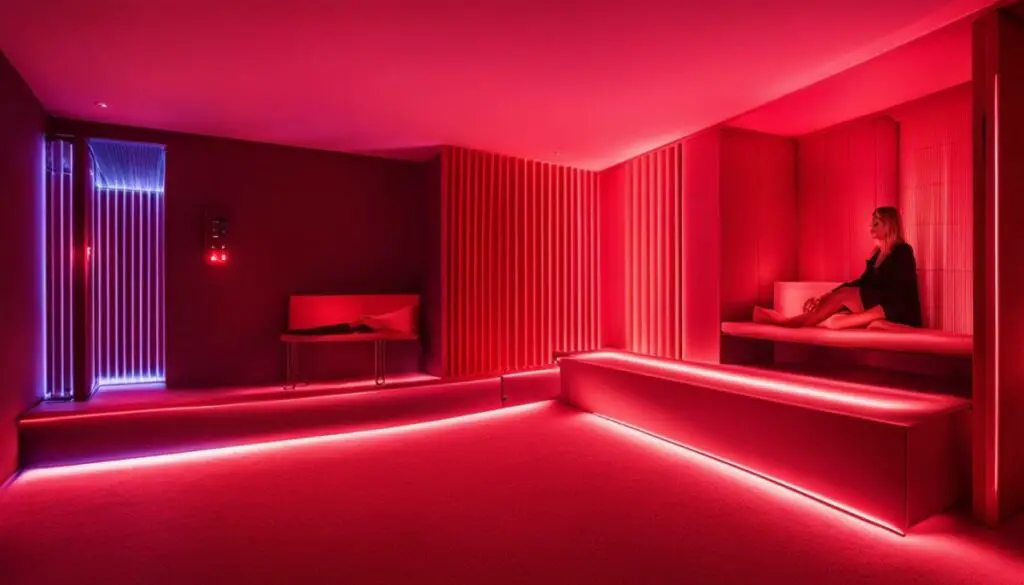Last Updated on 6 months by Francis
When it comes to wellness therapies, there are many different options available, each with its unique benefits and applications. Two popular modalities are infrared sauna and red light therapy, both of which utilize light to promote health and well-being. However, despite some similarities, there are significant differences between these two therapies.
In this section, we will delve into the differences between infrared sauna and red light therapy, exploring how each therapy works and the unique benefits they offer. By understanding these distinctions, you can make an informed decision about which therapy may be most suitable for your individual needs.
Contents
Key Takeaways
- Infrared sauna and red light therapy are two different modalities, although they both involve light to promote health and wellness.
- There are significant differences between infrared sauna and red light therapy, including energy source, application methods, and types of light used.
- Choosing between infrared sauna and red light therapy depends on individual needs and preferences.
What is Infrared Sauna?

Infrared sauna therapy involves the use of infrared heaters to emit infrared light, which is absorbed by the skin and penetrates deeper into the body. The heat generated by infrared light causes the body to sweat, helping to flush out toxins and impurities. This type of therapy is becoming increasingly popular for its numerous health benefits.
Benefits of Infrared Sauna:
| Detoxification | Relaxation | Pain Relief | Improved Circulation |
|---|---|---|---|
| Infrared sauna therapy can help rid the body of harmful toxins and heavy metals. | The heat and warmth of the sauna can help relax muscles and ease tension. | Infrared sauna therapy can aid in pain management, relieving aches and discomfort. | The heat from the infrared sauna can help increase blood flow, leading to better circulation and oxygenation of tissues. |
So, how does infrared sauna therapy work? Unlike traditional saunas, which use steam or hot air to heat the body, infrared saunas use infrared light to generate heat. This light is able to penetrate deeper into the body, reaching internal organs and tissues, and causing the body to heat up from the inside out. As a result, infrared sauna therapy is more effective at promoting relaxation, detoxification, and pain relief than traditional saunas. Plus, it doesn’t produce the same intense heat and discomfort that can be associated with steam or hot air saunas.
Overall, infrared sauna therapy is a safe and effective way to improve your health and well-being. Whether you’re looking to detoxify your body, reduce stress, or manage chronic pain, infrared sauna therapy may be the solution you’ve been searching for.
What is Red Light Therapy?

Red light therapy (RLT) is a form of phototherapy that utilizes red and near-infrared light to stimulate cellular function and promote healing in the body. This therapy has been extensively researched for its potential benefits in a variety of health and wellness applications.
When red and near-infrared light is absorbed by the cells in the body, it triggers a response that helps to improve cellular function and reduce inflammation. This, in turn, can lead to a range of health benefits for individuals who incorporate RLT into their health routines.
Benefits of Red Light Therapy
There are numerous health benefits associated with red light therapy. Some of the most prominent include:
- Improved skin health and reduced appearance of wrinkles and fine lines
- Reduced inflammation and pain management
- Faster wound healing and tissue repair
- Improved mood and mental clarity
- Enhanced muscle recovery and athletic performance
While research is ongoing, the potential benefits of red light therapy are quickly becoming more widely recognized. This therapy is non-invasive, painless, and free of side effects, making it a safe and effective option for individuals seeking a natural approach to wellness.
How Does Red Light Therapy Work?
The therapeutic effects of red light therapy are thought to occur through a number of mechanisms. One of the most prominent is the influence of red and near-infrared light on cellular mitochondria, which play a key role in producing ATP, the energy currency of the cell. By stimulating ATP production, red light therapy can improve cellular function and promote healing throughout the body.
Red light therapy has also been shown to have a positive impact on the immune system, reducing inflammation and promoting tissue repair. Additionally, this therapy can help to improve circulation and reduce oxidative stress, two factors that can contribute to a range of health issues.
Overall, the therapeutic benefits of red light therapy are thought to result from the interaction of red and near-infrared light with cells and tissues in the body. By promoting healing and improving cellular function, this therapy offers a safe and effective approach to enhancing overall health and wellness.
Key Differences between Infrared Sauna and Red Light Therapy

While both infrared sauna and red light therapy offer unique health and wellness benefits, there are several key differences between the two modalities. Here is a detailed comparison:
| Factors | Infrared Sauna | Red Light Therapy |
|---|---|---|
| Energy Source | Infrared light | Red and near-infrared light |
| Application Method | Heat therapy that raises the body’s core temperature | Light therapy that exposes the skin to targeted wavelengths of light |
| Light Wavelengths | Primarily mid-infrared waves, which penetrate deeper into the skin and muscles | Primarily red and near-infrared waves, which are absorbed by the skin’s surface and trigger cellular responses |
| Therapeutic Effects | Detoxification, relaxation, pain relief, improved circulation, weight loss | Skin rejuvenation, reduced inflammation, tissue repair, pain management, improved mood |
As the table demonstrates, the two therapies differ significantly in the energy source used, application method, and light wavelengths involved. Infrared sauna therapy primarily involves the use of mid-infrared waves to raise the body’s core temperature, which leads to various therapeutic benefits. On the other hand, red light therapy utilizes red and near-infrared wavelengths of light to trigger specific cellular responses, leading to a different set of therapeutic benefits.
Both modalities are effective in their own right and offer unique health advantages. Choosing which therapy is best suited for an individual comes down to personal preferences and specific health needs.
Infrared Sauna Benefits and Applications

Using an infrared sauna provides a wide range of benefits for both the body and mind. Here are some of the most notable benefits of infrared sauna therapy:
| Benefits of Infrared Sauna |
|---|
| Detoxification: Infrared sauna helps to release toxins from the body through sweating, allowing for a deep cleanse that can improve overall health. |
| Weight Loss: As the body sweats during an infrared sauna session, it burns calories and can boost metabolism, leading to weight loss. |
| Stress Reduction: Infrared sauna therapy can help to reduce stress levels and promote relaxation, allowing for greater emotional and mental well-being. |
| Pain Relief: Infrared sauna has been shown to relieve pain associated with conditions such as arthritis, fibromyalgia, and muscle strains. |
| Improved Circulation: The infrared heat from the sauna helps to increase blood flow and reduce inflammation, promoting better circulation and overall cardiovascular health. |
Additionally, infrared sauna therapy can be used for a variety of applications, from post-workout recovery to general wellness maintenance. It can also be used in combination with other therapies, such as massage or aromatherapy, for an even more comprehensive wellness experience.
Red Light Therapy Benefits and Applications

Red light therapy offers a vast array of health benefits and has various applications that make it an increasingly popular therapy in recent years. This therapy utilizes low-level wavelengths of red and near-infrared light to stimulate cellular function, promoting healing and rejuvenation throughout the body.
Some of the primary benefits of red light therapy include:
- Improved skin health: Red light therapy stimulates collagen production, reducing wrinkles, fine lines, and acne.
- Reduced inflammation: By decreasing inflammation, red light therapy can help manage conditions such as arthritis and chronic pain.
- Enhanced muscle recovery: Red light therapy can speed up recovery time from injuries and improve athletic performance by increasing blood flow and reducing muscle fatigue.
- Improved mood: Red light therapy can have a positive impact on mental health by improving mood and reducing symptoms of depression and anxiety.
Furthermore, red light therapy has several applications, including:
| Application | Description |
|---|---|
| Skin Rejuvenation | Red light therapy stimulates collagen production, reducing wrinkles, fine lines, and other signs of aging. |
| Wound Healing | Red light therapy promotes tissue repair and skin regeneration, making it a valuable treatment for wounds and other injuries. |
| Pain Management | Red light therapy can reduce pain and inflammation associated with chronic conditions such as arthritis and fibromyalgia. |
| Muscle Recovery | Red light therapy improves blood flow and reduces muscle fatigue, making it a popular therapy for athletes and those recovering from injuries. |
| Mental Health | Red light therapy can have a positive impact on mood and reduce symptoms of depression and anxiety. |
As you can see, red light therapy has numerous health benefits and applications, making it a versatile therapy for various conditions and individuals.
How Does Infrared Sauna Work?
Understanding the science behind infrared sauna therapy can help one appreciate its many benefits. At its core, infrared sauna therapy involves the use of far-infrared radiation to penetrate the skin and provide warmth and therapeutic effects.
The far-infrared radiation from the sauna penetrates up to 1.5 inches beneath the skin, promoting internal warming and sweating. The resulting sweating can help rid the body of toxins and impurities, leading to a sense of overall well-being.
One of the key mechanisms behind infrared sauna therapy is heat shock proteins, which are a type of protein that helps the body adapt to stressors like heat. Infrared sauna therapy has been shown to increase heat shock protein expression, leading to health benefits like improved cardiovascular health and increased longevity.
“Infrared sauna therapy involves the use of far-infrared radiation to penetrate the skin and provide warmth and therapeutic effects.”
Another interesting aspect of infrared sauna therapy is its ability to improve blood flow and circulation. The heat from the sauna can help dilate blood vessels, increasing blood flow to various parts of the body. This can lead to improved cardiovascular function and better oxygen delivery to tissues throughout the body.
The therapeutic effects of infrared sauna therapy are numerous and well-documented. From providing pain relief to promoting relaxation and detoxification, the benefits of infrared sauna are hard to ignore.
How Does Red Light Therapy Work?

Red light therapy (RLT) functions by utilizing low-level wavelengths of red and near-infrared light to stimulate cellular function. These wavelengths penetrate the skin, reaching the mitochondria within the cells. When the light energy reaches the mitochondria, it increases the production of adenosine triphosphate (ATP), which is the primary source of energy for cellular function.
The increased production of ATP results in a range of beneficial biological responses, including improved circulation, reduced inflammation, and increased collagen production. The red and near-infrared light also activates certain enzymes within the cells, which can further enhance the therapeutic benefits of RLT.
One of the key mechanisms of action of RLT is its ability to trigger a process known as photobiomodulation. This process involves the release of nitric oxide, which can increase blood flow and reduce pain and inflammation. The light energy also activates specific receptors within the cells, which can lead to gene expression changes and further biological responses.
Recent research has demonstrated the effectiveness of RLT in treating a range of conditions, including skin aging, acne, pain management, and even depression. By stimulating cellular function and promoting healing, RLT offers a non-invasive and natural approach to improving overall health and well-being.
Which is Better: Infrared Sauna or Red Light Therapy?

When it comes to choosing between infrared sauna and red light therapy, there is no one-size-fits-all answer. Both therapies offer unique benefits and have different mechanisms of action. Therefore, it is essential to understand your individual needs and preferences and choose the therapy that suits you best.
Let’s compare the two therapies in a table to help you gain a better understanding of their differences:
| Infrared Sauna | Red Light Therapy | |
|---|---|---|
| Energy Source | Far-infrared rays produced by heating elements | Red and near-infrared light |
| Application Method | Sitting in a heated sauna room | Using a light panel or device |
| Wavelength of light | 6-14 microns | 600-1000 nanometers |
| Main Benefits | Detoxification, relaxation, pain relief, improved circulation | Skin rejuvenation, reduced inflammation, pain management, improved mood |
As you can see, the two therapies differ in their energy source, application method, wavelength of light, and primary benefits. Infrared sauna uses far-infrared rays to heat the body, while red light therapy uses specific wavelengths of light to stimulate cellular function.
Infrared sauna is effective in promoting relaxation, reducing stress, and aiding detoxification. It also has a positive impact on circulation and can be used for pain relief. Red light therapy, on the other hand, is beneficial for skin health, wound healing, and reducing inflammation. It also improves mood and can be used for muscle recovery.
Therefore, if you are looking for stress relief, detoxification, and general relaxation, then infrared sauna may be the better option for you. If you are interested in improving skin health, reducing inflammation, and enhancing mood, red light therapy may be a better choice.
However, keep in mind that combining both therapies can also provide a synergistic effect and offer more comprehensive health benefits. Think about your goals and consider trying both therapies to see which works best for you.
Exploring the Synergy: Combining Infrared Sauna and Red Light Therapy
When it comes to improving your health and wellness, why choose between infrared sauna and red light therapy when you can have both? Combining these two therapies can provide a more holistic approach to promoting overall well-being.
By using infrared sauna and red light therapy together, you can achieve enhanced benefits such as:
| Benefits of Infrared Sauna | Benefits of Red Light Therapy |
|---|---|
| Detoxification | Skin rejuvenation |
| Improved circulation | Reduced inflammation |
| Pain relief | Pain management |
| Relaxation | Improved mood |
Combining these two therapies can also provide a more efficient way to address a wide range of health concerns. Infrared sauna therapy can help stimulate blood flow and relax muscles, while red light therapy can promote cellular function and rejuvenate the skin. Used together, these therapies can provide a comprehensive approach to enhancing overall health.
Additionally, combining infrared sauna and red light therapy can be a more time-effective approach to achieving results. With busy schedules, finding the time for multiple therapy sessions can be challenging. Combining these therapies allows for a more streamlined approach, ultimately saving time and providing more efficient results.
Overall, combining infrared sauna and red light therapy can offer a synergistic effect that provides enhanced benefits for overall health and wellness. Consider incorporating both therapies into your health routine to experience the full range of benefits they offer.
Conclusion
As we conclude our exploration of infrared sauna and red light therapy, we can see that while they share some similarities, they are not the same.
It is true that both therapies offer unique health and wellness benefits. Infrared sauna therapy can help with detoxification, relaxation, pain relief, and improved circulation. Red light therapy, on the other hand, can aid in skin rejuvenation, reduced inflammation, pain management, and improved mood.
While the benefits of each therapy may appear similar, they differ in terms of energy sources, application methods, and wavelengths of light used. It is important to consider individual needs and preferences when choosing between the two.
Is Infrared Sauna the Same as Red Light Therapy?
The answer is no.
Infrared sauna therapy uses infrared light to heat the body, promoting detoxification and overall relaxation. Red light therapy, on the other hand, uses specific wavelengths of red and near-infrared light to target cells and promote healing.
By understanding these differences, individuals can make informed decisions about which therapy may be more suitable for their needs.
Choose the Best Therapy for Your Needs
Whether you choose infrared sauna therapy or red light therapy, both modalities offer a range of health and wellness benefits. It is important to identify your personal health goals and preferences in order to make the best decision.
By incorporating either or even both therapies into your daily routine, you can take steps towards improving your overall well-being.
Experience the Synergy of Both Therapies
For those looking to maximize the benefits of both therapies, combining infrared sauna and red light therapy can offer a holistic approach to health and wellness.
By using both modalities together, individuals can experience the potential synergistic effects and further enhance the therapeutic benefits of each.
Overall, whether you choose to use infrared sauna therapy, red light therapy, or both, it is important to prioritize your health and well-being. By understanding the unique benefits of each therapy, you can make an informed decision and take steps towards achieving optimal health.
FAQ
Is infrared sauna the same as red light therapy?
No, infrared sauna and red light therapy are different modalities of therapy. While both involve the use of light, they utilize different energy sources, application methods, and wavelengths of light.
What is infrared sauna?
Infrared sauna is a therapy that uses infrared light to create heat, which is then absorbed by the body. This heat promotes detoxification, relaxation, pain relief, and improved circulation.
What is red light therapy?
Red light therapy is a therapy that utilizes specific wavelengths of red and near-infrared light to stimulate cellular function. It has numerous benefits including skin rejuvenation, reduced inflammation, pain management, and improved mood.
What are the key differences between infrared sauna and red light therapy?
The main differences between infrared sauna and red light therapy lie in the energy source used, application methods, and the specific wavelengths of light. Infrared sauna uses infrared light to create heat, while red light therapy utilizes specific wavelengths of red and near-infrared light.
What are the benefits and applications of infrared sauna?
Infrared sauna therapy offers a range of benefits including detoxification, weight loss, stress reduction, and overall well-being. It can be used to promote relaxation, aid in pain relief, support cardiovascular health, and improve skin appearance.
What are the benefits and applications of red light therapy?
Red light therapy has a wide range of benefits including skin health, wound healing, muscle recovery, and mood enhancement. It can be used to improve the appearance of the skin, reduce inflammation, manage pain, and promote cellular regeneration.
How does infrared sauna work?
Infrared sauna works by emitting infrared light, which penetrates the skin and is absorbed by the body. This absorbed energy produces heat, which increases body temperature and promotes various therapeutic effects such as detoxification and improved circulation.
How does red light therapy work?
Red light therapy works by delivering specific wavelengths of red and near-infrared light to the body. These wavelengths interact with cells, triggering biological responses that enhance cellular function, promote healing, reduce inflammation, and improve overall well-being.
Which is better: infrared sauna or red light therapy?
The choice between infrared sauna and red light therapy depends on individual needs and preferences. Both therapies offer unique benefits, and the decision should be based on personal health goals and desired outcomes.
Can I combine infrared sauna and red light therapy?
Yes, combining infrared sauna and red light therapy can provide a synergistic approach to health and wellness. The two therapies can complement each other, offering a holistic and comprehensive approach to achieving optimal results.









